AUDI A7 2018 Owners Manual
Manufacturer: AUDI, Model Year: 2018, Model line: A7, Model: AUDI A7 2018Pages: 274, PDF Size: 42.77 MB
Page 201 of 274
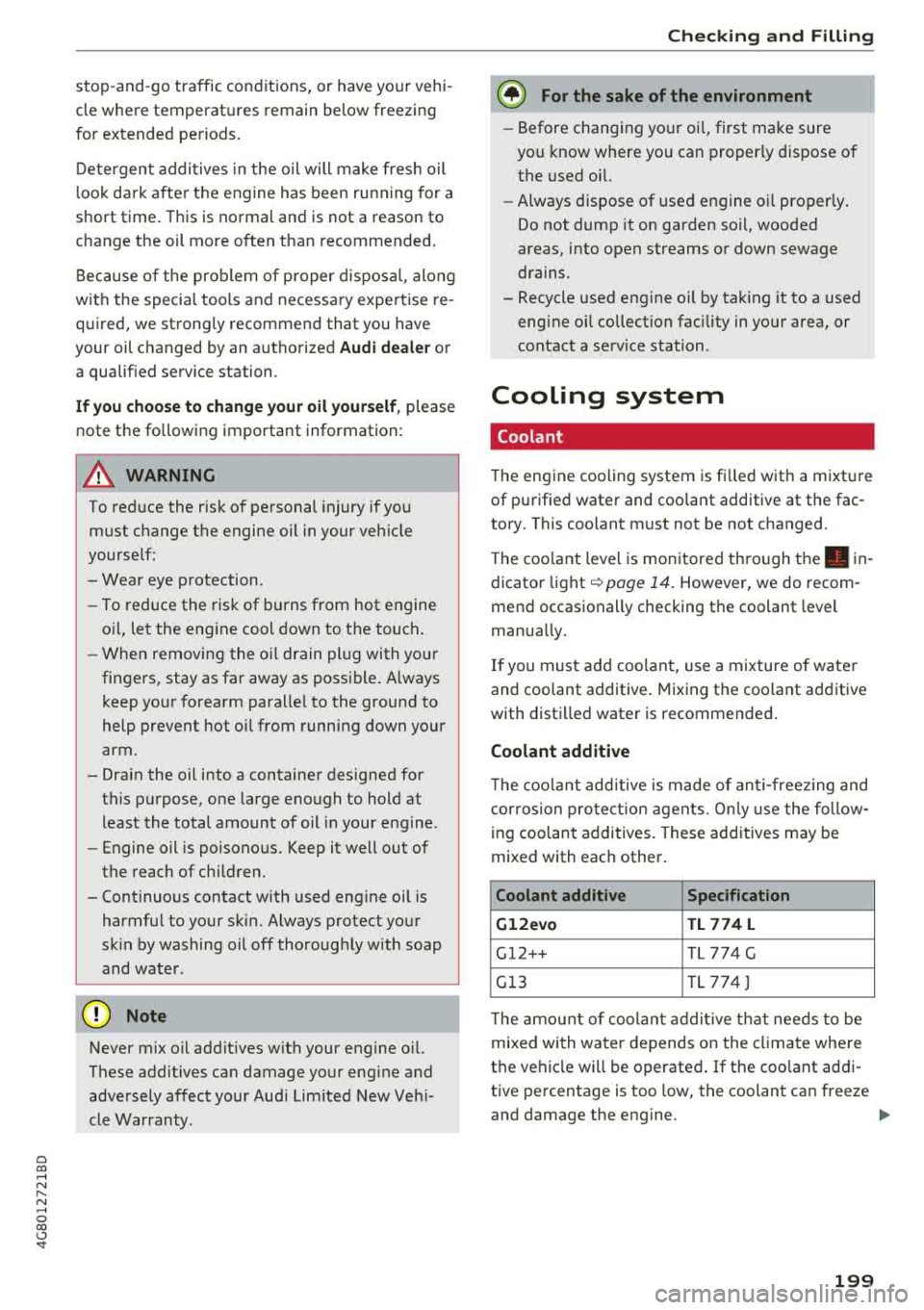
a co .... N
" N .... 0 00 \,;J '
cle where temperatures remain below freezing
for extended periods.
Detergent additives in the oil will make fresh oil
l ook dark after the engine has been running for a
short time. This is norma l and is not a reason to
change the oil more often than recommended.
Because of the problem of proper disposa l, along
with the special tools and necessary expertise re
quired, we strong ly recommend that you have
your oil changed by an authorized
Audi dealer or
a qualified service station .
If you choose to change your oil yourself, please
note the following important information:
A WARNING
To reduce the risk of personal injury if you
must change the engine oil in your veh icle
yourself:
- Wear eye protection.
- To reduce the risk of burns from hot engine
o il, let the eng ine cool down to the touch.
-
-When removing the oil drain plug with your
fingers, stay as far away as possible. Always
keep your forearm parallel to the ground to
help prevent hot oil from running down your
arm.
- Drain the oil into a container designed for
this purpose, one large enough to hold at
least the total amount of oil in your engine .
- Engine oil is poisonous. Keep it well out of
the reach of children.
- Cont inuous contact w ith used engine oil is
harmful to your sk in. Always protect your
sk in by washing oil off thoroughly w ith soap
and water.
@ Note
Never mix oil addit ives with your engine o il.
These additives can damage your eng ine and
adversely affect your Audi Limited New Vehi
cle Warranty.
Checking and Filling
@) For the sake of the environment
-Before changing your oi l, first make sure
you know where you can properly dispose of
the used oil.
- Always dispose of used engine oi l properly.
Do not dump it on garden soil, wooded
areas, into open streams or down sewage
drains.
- Recycle used engine o il by tak ing it to a used
eng ine oil collection fac ility in your area, or
contact a service station .
Cooling system
Coolant
The engine cooling system is filled wit h a mixture
of purified water and coolant additive at the fac
tory. This coolant must not be not changed.
T he coolant level is monitored through
the . in
dicator light
r=;, page 14. However, we do recom
mend occasionally checking the coolant leve l
manua lly.
If you must add coolant, use a mixture of water
and coolant additive. Mixing the coo lant additive
with distilled water is recommended.
Coolant additive
The coolant additive is made of anti-freezing and
corrosion protection agents. Only use the follow
ing coolant additives. These additives may be
mixed with each other .
Coolant additive Specification
Gl2evo
TL 774 L
Gl2++ TL 774 G
Gl3 TL 774
J
The amount of coolant additive that needs to be
mixed with water depends on the climate where
the vehicle wi ll be operated .
If the coolant addi
tive percentage is too low, the coolant can freeze
and damage the engine.
.,.
199
Page 202 of 274

Checking and Filling
Coolant Freeze protec-
additi ve tion
Warm min. 40% min. -13 °F
regions max. 45% (-25 °C)
Cold min. 50% max. -40
°F
regions max. 55% (-40 °C)
([) Note
- Before the start of winter, have an author
ized Audi dealer or authorized Audi Service
Facility check if the coolant additive in your
vehicle matches the percentage appropriate
for the climate. This is especially important
when driving in colder climates.
- If the appropriate coolant additive is not
available in an emergency, do not add any
other additive. You could damage the en
gine. If this happens, only use water and re store the correct mixture ratio with the
spec ified coolant additive as soon as possi
ble.
- Only refill with new coo lant.
- Radiator sealant must not be mixed w ith
the coo lant .
Adding coolant
F ig. 183 Engine compartment: coolant expans ion tank
cover
Observe the safety precautions~ page 193,
Working in the engine compartment .
Checking the engine coolant level
• Park the vehicle on a leve l surface .
• Switch the ignition off.
• Read the coolan t leve l on the coo la nt expansion
tank
~page 196, fig . 181. The coolant level
must be between the MIN and MAX markings
200
when the engine in cold. When the engine is
warm it can be slightly above the MAX marking .
Adding coolant Requirement: there must be a residual amount of
coolan t in the expansion tan k
~CD -
• Let the engine cool down .
• Place a cloth over the coolant expansion tank
cap and unscrew the cap counterclockw ise
~ & -
... Add coo lant m ixed in the cor rect ratio
~ page 199 up to the MAX marking.
• Make sure that the fluid level remains stab le .
Add more coolant if necessary .
• Close the cap securely.
Coolant loss usually ind icates there is a leak . Im
mediate ly drive your vehicle to an authorized
Audi dealer or authorized Audi Service Fac ility
and have the cooling system inspected. If the
cooling system is not leaking, a loss can come
from the coolant boiling through overheat ing
and being pushed out of the cooling system .
A WARNING
- The cooling system is under pressure. Do
not open the coo lant expansion ta nk cap
when the engine is hot. This increases the
risk o f bur ns.
- The coolan t addi tive and the coolant can be
dangerous to your health. For t his reason,
keep the coolant in the original container
and away from children. There is a risk of
poisoning.
- When working in the engine compartment,
remember that the radiator fan can switch
on even if the ignition is switched off, which
increases the risk of injury.
(D Note
Do not add coolant if the expansion tank is
empty. A ir cou ld enter the cooling system and
damage the engine. If this is the case, do not
continue driving. See an authorized Audi deal
er or authorized Audi Serv ice Facility for assis
tance.
Page 203 of 274
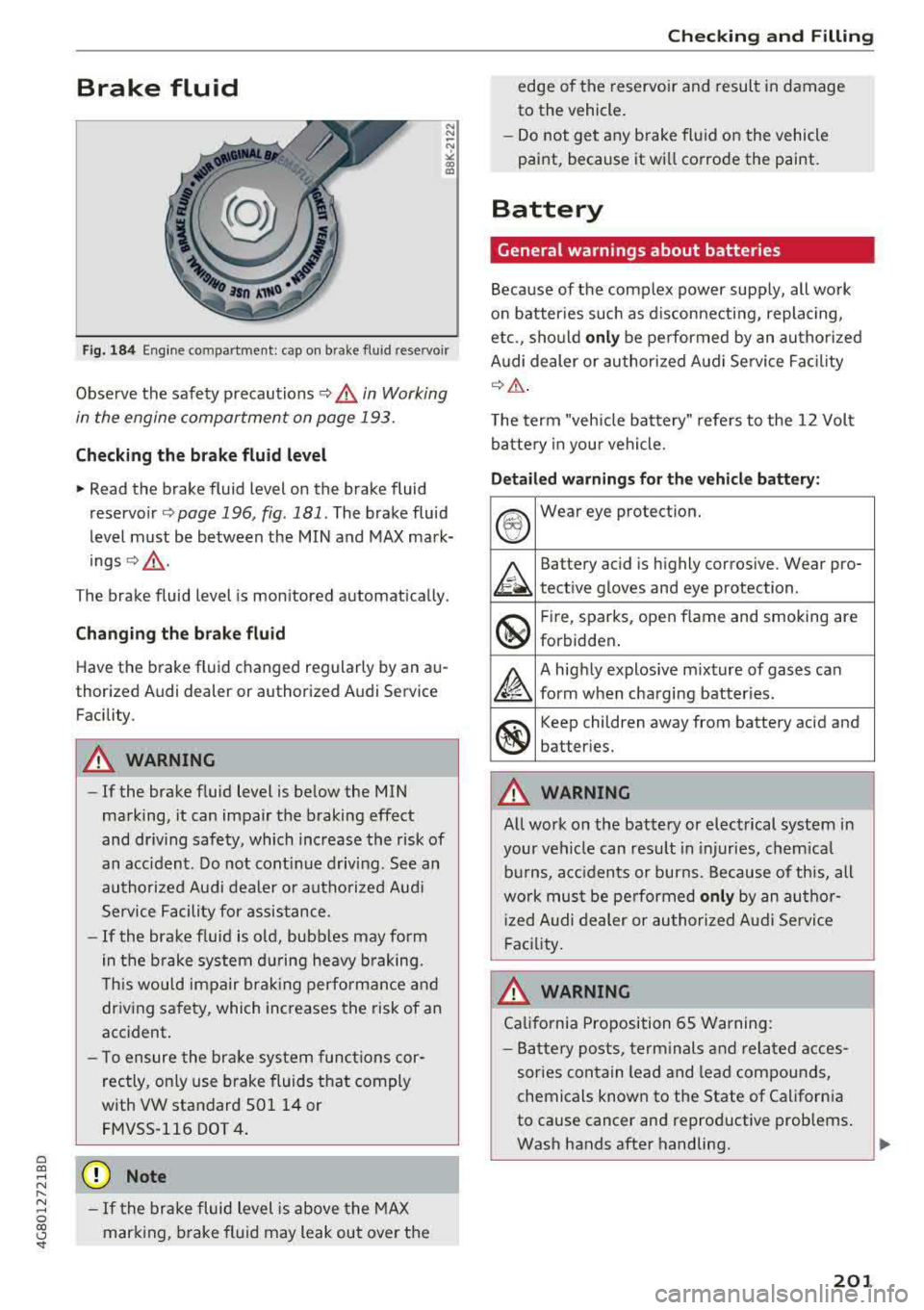
a co ,...,
N
" N ,...,
0 00 <..:l '
N N ~
~ co al
Fig. 184 Eng ine compartment: cap on brake fluid reservoir
Observe the safety precautions ~.&. in Working
in the engine comportment on page 193.
Checking th e brake fluid level
• Read the brake fluid level on the brake fluid
reservo ir
Q page 196, fig. 181. The brake fluid
level must be between the MIN and MAX mark
ings ~,&. .
The brake fluid level is mon itored automat ically.
Chang ing the bra ke flu id
Have the brake fluid changed regularly by an au
thorized Audi dealer or authorized Audi Service
Facility .
A WARNING
-If the brake fluid level is be low the MIN
marking, it can impair the braking effect
and dr iving safety, which increase the risk of
an acc ident. Do not cont inue driv ing . See an
authorized Audi deale r or autho rized Aud i
Service Facility for assist ance .
-If the brake f luid is o ld, bubbles may form
in the brake system d uring heavy b raking.
T his would impair bra king perfo rman ce an d
driving safety, which increases the risk of an
accident.
- T o ensure the bra ke system functions cor
rectly, only use brake fluids that comply
with VW standard 501 14 or FMVSS-116 DOT
4 .
(D Note
- If the brake fluid level is above the MAX
mar king, brake fluid may leak out over the
Chec king and Filling
edge of the reservo ir and result in damage
to the vehicle.
- Do not get any b rake fl uid on the vehicle
paint, because it wi ll co rrode the paint .
Battery
General warnings about batteries
Because of the complex power supp ly, alt work
o n batter ies such as d isconnecting , replacing,
etc., sho uld
onl y be performed by an au tho riz ed
Audi dealer or au thori zed Audi Se rvice Fac ility
Q A .
The term "vehicle battery" refe rs to the 12 Volt
batte ry in you r vehicle.
Detail ed warnings fo r the vehicle battery :
®
Wear eye protection.
A
Battery acid is highly corrosive. Wear pro-
tect ive gloves and eye protection .
@
Fire, sparks, open flame and smoking are
forbidden .
~
A highly explosive mixture of gases can
form w hen cha rging bat ter ies.
®
Keep children away from battery acid and
batter ie s.
A WARNING
A ll work on the battery or electrical system in
your vehicle can result in injuries, chem ica l
burns, acc idents or burns. Because of this, all
wo rk must be pe rformed
only by an au tho r
iz ed Audi dealer or au thor ized A udi Service
F aci lity.
A WARNING
-c....--
Ca lifornia Proposition 65 Warning:
- Battery posts, term inals and rela ted acces
sories contain lead and lead compounds,
chemicals known to the State of California
to cause cancer and reproductive prob lems .
Wash hands afte r handling.
201
Page 204 of 274
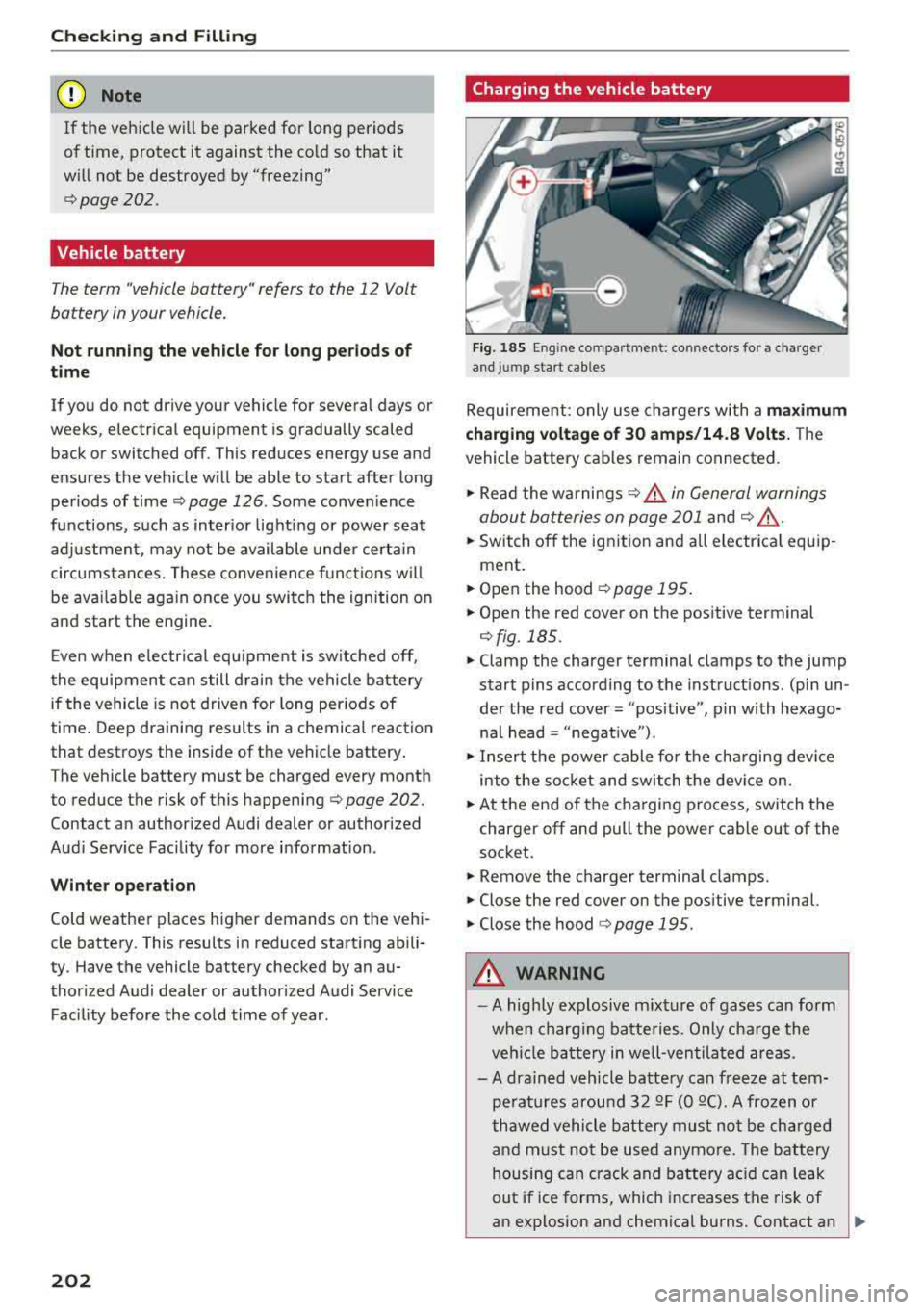
Checking and Filling
(D Note
If the vehicle will be parked for long periods
of t ime , protect it against the co ld so that it
will not be destroyed by "freezing"
c::> page 202 .
Vehicle battery
The term "vehicle battery " refers to the 12 Volt
bat tery in your vehicle.
Not running the vehicle for long pe riods of
t ime
If you do not drive your vehicle for several days o r
weeks , electri cal equipment is gr adually scaled
back or switched off . This reduces energy use and
ensures the veh icle w ill be able to start after long
periods of time
c::> page 126 . Some conve nience
functions, s uch as interior lighting or power seat
adj ustment, may not be available under certa in
circumstances. These convenience f unct ions w ill
be ava ilab le aga in once you switch the ignition on
and start the engine .
E ven w hen electrica l equ ipme nt is swi tched off,
the equipment can still d rain the vehicle battery
if the vehicle is not driven for long periods of
time . Deep draining results in a chemical reaction
that destroys the inside of the vehicle battery .
The vehicle battery must be charged every month
t o reduce the risk of this happening
c::> page 202.
Contact an author ized Audi dealer or authorized
Aud i Serv ice Facility for more information .
Winter operati on
Cold weather places higher demands on the vehi
cle battery. This results in reduced start ing abili
ty . Have the vehicle battery checked by an au
thor ized Audi dealer or authorized Audi Service
Facility before the co ld time of year .
202
Charging the vehicle battery
Fig. 18 5 En g in e compartment : co nn ectors fo r a cha rger
a n d jum p start cab les
Requireme nt: only use chargers with a maximum
charging voltage of 30 amp s/14.8 Volts.
The
vehicle battery cab les remain connected.
... Read the wa rnings c::> _& in General warnings
about batteries on page 201
and c::> ,& .
... Switch off the ign it ion and all electrica l equip
ment .
... Open the hood c::> page 195 .
... Open the red cover on the pos itive terminal
c::>fig. 185.
... Clamp the charger terminal clamps to the jump
start p ins accord ing to the instruct ions. (pin un
der the red cover
= " positive ", pin with hexago
nal head= "negat ive ").
... In sert t he power cable fo r th e cha rging dev ice
into the soc ket and switch t he devi ce on.
... At the end of the cha rging process, switch the
charger off and pull the power cable out of the
soc ket .
... Remove the charger terminal clamps.
... Close the red cover on the pos itive terminal.
... Close the hood c::> page 195 .
A WARNING
-A highly explosive m ix ture of gases can form
when charg ing batte ries . Only cha rge the
veh icle b attery in well -ventila ted areas.
- A drained vehicle batte ry can freeze at tem
pe ra tu res around 32
QF (0 QC). A fro zen o r
thawed vehicle battery must no t be charged
a nd must not be used anymore. The battery
housing can c rack and battery ac id can leak
out if ice forms, which increases the risk of
an explosion and chemical burns. Contact an
..,.
Page 205 of 274

a co .... N
" N .... 0 00 \.J '
Service Facility for more information.
- Do not connect or disconnect the charging
cable while charging because this increases
the risk of an exp losion.
(D Tips
- Only charge the vehicle battery through the
connections in the engine compartment.
- Read all of the manufacturer's instructions
for the charger before charging the vehicle
battery.
Windshield washer system
Fig. 186 Engine compa rtment: washer flu id reservo ir cap
M N
-N ~
"' a,
The windshield washer reservoir O contains the
cleaning solution for the windshie ld and the
headlight washer
system* ¢ page 196, fig . 181.
The reservoir capacity can be found in
¢page 254.
To reduce the risk of lime sca le deposits on the
spray nozzles, use clean water with low amounts
of calc ium . A lways add window cleaner to the wa
ter. When the outs ide temperatures are cold, an
anti -freezing agent should be added to the water
so that it does not freeze .
@ Note
-The concentration of anti-freezing agent
must be adjusted to the vehicle operating
cond itions in the respective climate. A con
ce ntration that is too high can lead to vehi
cle damage.
- Never add radiator anti-freeze or other addi
tives to the washer fluid.
Checking and Filling
- Do not use a glass cleaner that contains
paint so lvents, because t his could damage
the paint.
Service interval display
The service interval display detects when your ve
hicle is due for service .
The service interval display works in two stages:
-Inspection or oil change reminder : afte r a cer -
tain distance driven, a message appears in the
instrument cluster display each time the igni
tion is switched on or off. The remaining dis
tance or time is disp layed briefly.
- Inspection or oil change due: if your vehicle
has reached an inspection or oil change interval
or both intervals at the same t ime, the mes
sage
Inspection due! or Oil change due! or Oil
change and inspection due!
appears briefly af
ter switching the ignition on/off .
Checking service intervals
You can check the remaining distance or time un
til the next oil change or next inspection in the
Car menu. To do t his, select: the !CAR !function
button
> (Car)* Systems control button > Service
& control > Service intervals .
Resetting the indicator
An authorized Audi dea ler or a uthorized Audi
Service Facility w ill reset the service interval dis
play after performing service.
If you have ch anged the oi l yourse lf, you must re
set the oil change interval.
T o reset the indicator, select : the
I CAR ! function
button
> (Car)* Systems control button > Service
& control > Service intervals . Turn the control
knob downward to
Reset oil change interval and
press the control knob.
@ Note
-Only reset the oi l change indicator if the oi l
was changed.
- Following the service intervals is critical to
maintaining the service life and value of
your vehicle, especially the engine. Even if
203
Page 206 of 274
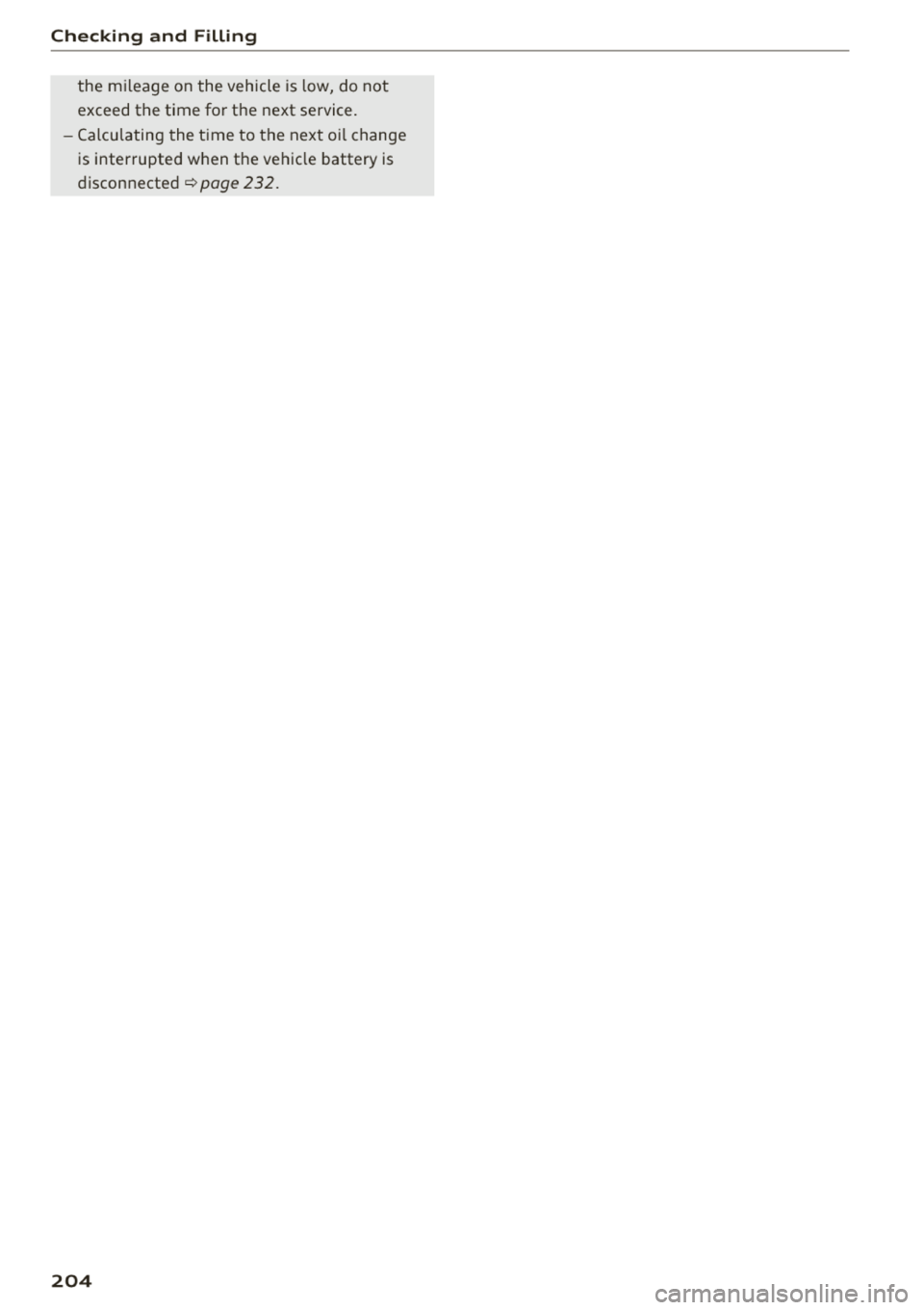
Checking and Filling
the mileage on the vehicle is low, do not
exceed the time for the next service.
- Calculating the time to the next oi l change
is interrupted when the vehicle battery is
disconnected
r=> page 232.
204
Page 207 of 274
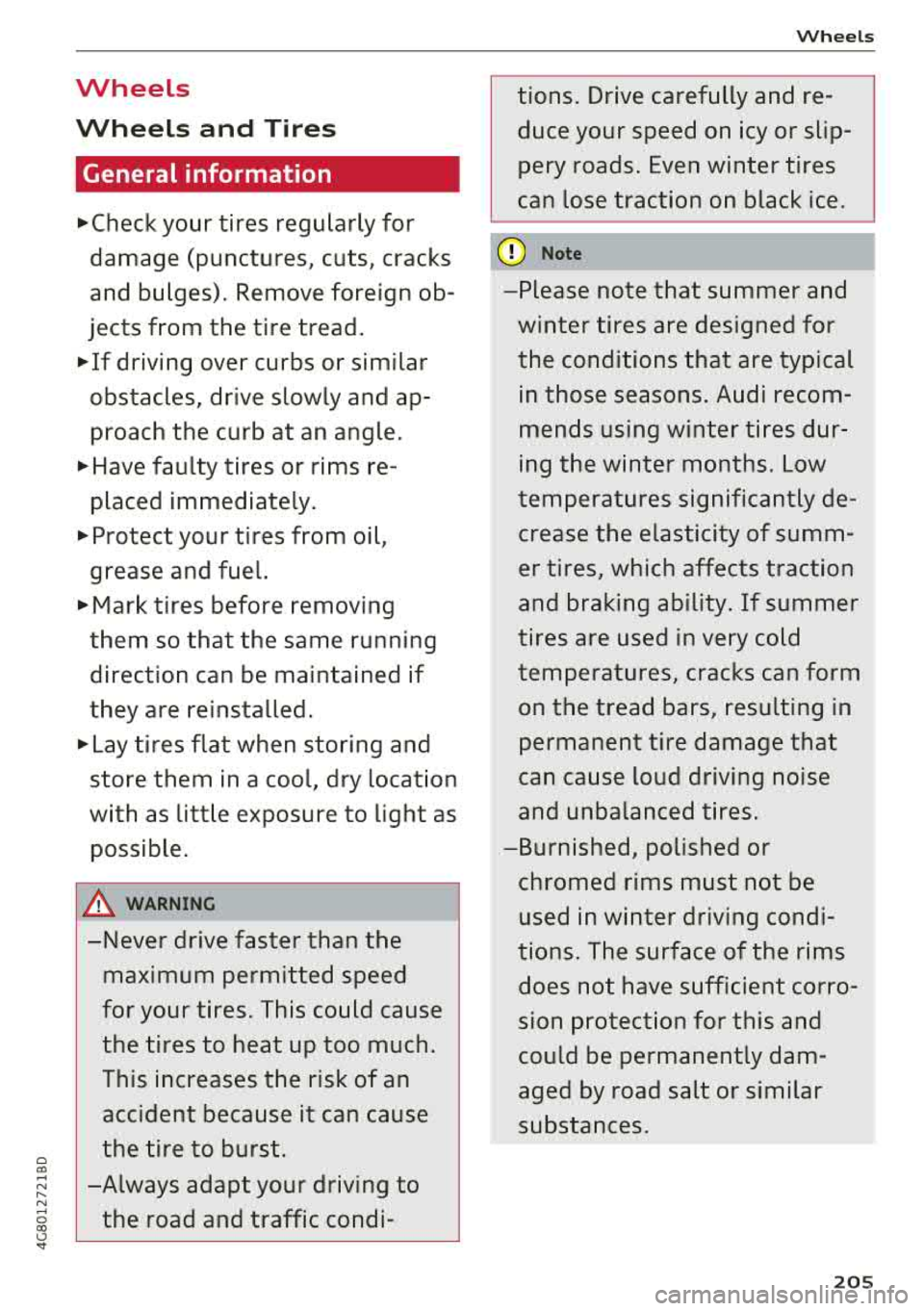
0 0)
-N ,.... N
-0 0) \.) ..
Wheels
Wheels and Ti re s
General information
.,,.Check your tires regularly for
damage (punctures, cuts , cracks
and bulges). Remove foreign ob
jects from the tire tread .
.,,. If driving over curbs or similar
obstacles, drive slowly and ap
proach the curb at an angle.
.,,. Have faulty tires or rims re
placed immediately .
.,,.Protect your tires from oil ,
grease and fuel.
.,,. Mark tires before removing
them so that the same running
direction can be maintained if
they are reinstalled .
.,,.Lay tires flat when storing and
store them in a cool, dry locat ion
with as litt le exposure to light as
possible .
&_ WARNING -
-Never drive faster than the
maximum permitted speed
for your tires. This could cause the tires to heat up too much .
This increases the risk of an
acc ident because it can cause
the tire to burst.
-Always adapt your driving to the road and traffic condi-
Wheels
tions. Drive carefully and re
duce your speed on icy or slip
pery roads . Even winter tires
can lose traction on black ice .
@ N ot e
-Please note that summer and
winter tires are designed for
the condit ions that are typical
in those seasons. Audi recom
mends using winter ti res dur
ing the winter months. Low
temperatures significantly de crease the e lasticity of summ
er tires , which affects traction
and braking ab ility . If summer
tires are used in very cold
temperatures, cracks can form on the tread bars, resulting in
permanent tire damage that
can cause loud driving noise
and unbalanced tires.
-Burnished, polished or chromed rims must not be
used in winter driving condi
tions . The surface of the rims
does not have sufficient corro
sion protect ion for this and
could be permanently dam
aged by road salt or similar
substances.
205
Page 208 of 274
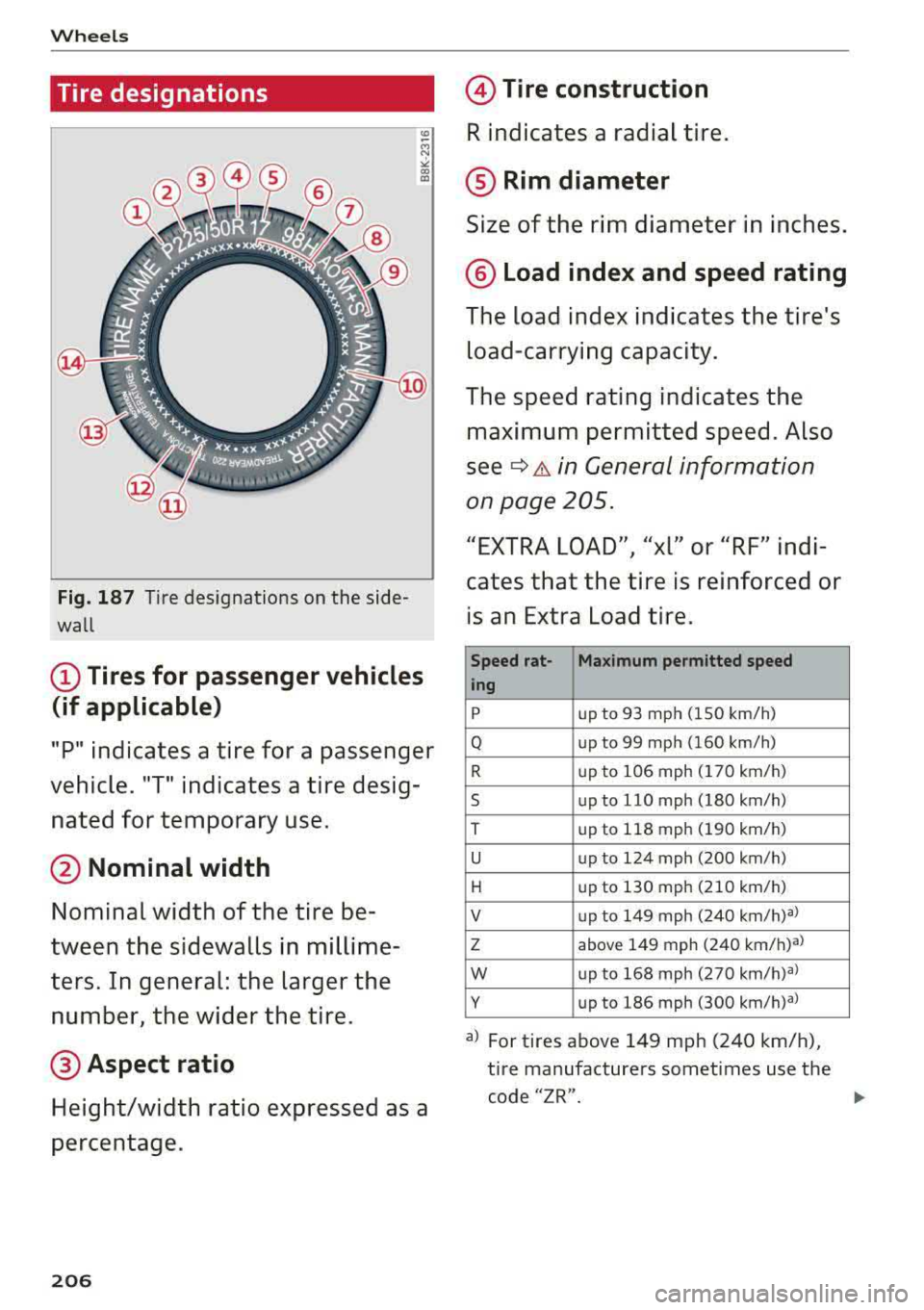
Wheels
Tire designations
Fig. 187 Tire designations on the side
wall
(D Tires for passenger vehicles
(if applicable)
"P" indicates a tire for a passenger
vehicle. "T" indicates a tire desig
nated for temporary use.
@ Nominal width
Nominal width of the tire be
tween the sidewalls in millime
ters. In general: the larger the
number, the wider the tire.
@ Aspect ratio
Height/width ratio expressed as a
percentage.
206
@ Tire construction
R indicates a radial tire.
® Rim diameter
Size of the rim diameter in inches.
® Load index and speed rating
The load index indicates the tire's
load-carrying capacity.
The speed rating indicates the maximum permitted speed. Also
see
¢ A in General information
on page 205.
"EXTRA LOAD", "xl" or "RF" indi
cates that the tire is reinforced or
is an Extra Load tire.
Speed rat-
Maximum permitted speed
ing
p
up to 93 mph (150 km/h)
Q up to 99 mph (160 km/h)
R up to 106 mph (170 km/h)
5 up to 1 1 0 mph (180 km/h)
T up to 118 mph (190 km/h)
u up to 124 mph (200 km/h)
H up to 130 mph (210 km/h)
V up to 149 mph (240 km/h)al
z abov e 149 mph (240 km/h) al
w up to 168 mph (270 km/h)al
y up to 186 mph (300 km/h) al
a) For tires above 149 mph (240 km/h),
tire manufacturers sometimes use the
code "ZR".
Page 209 of 274
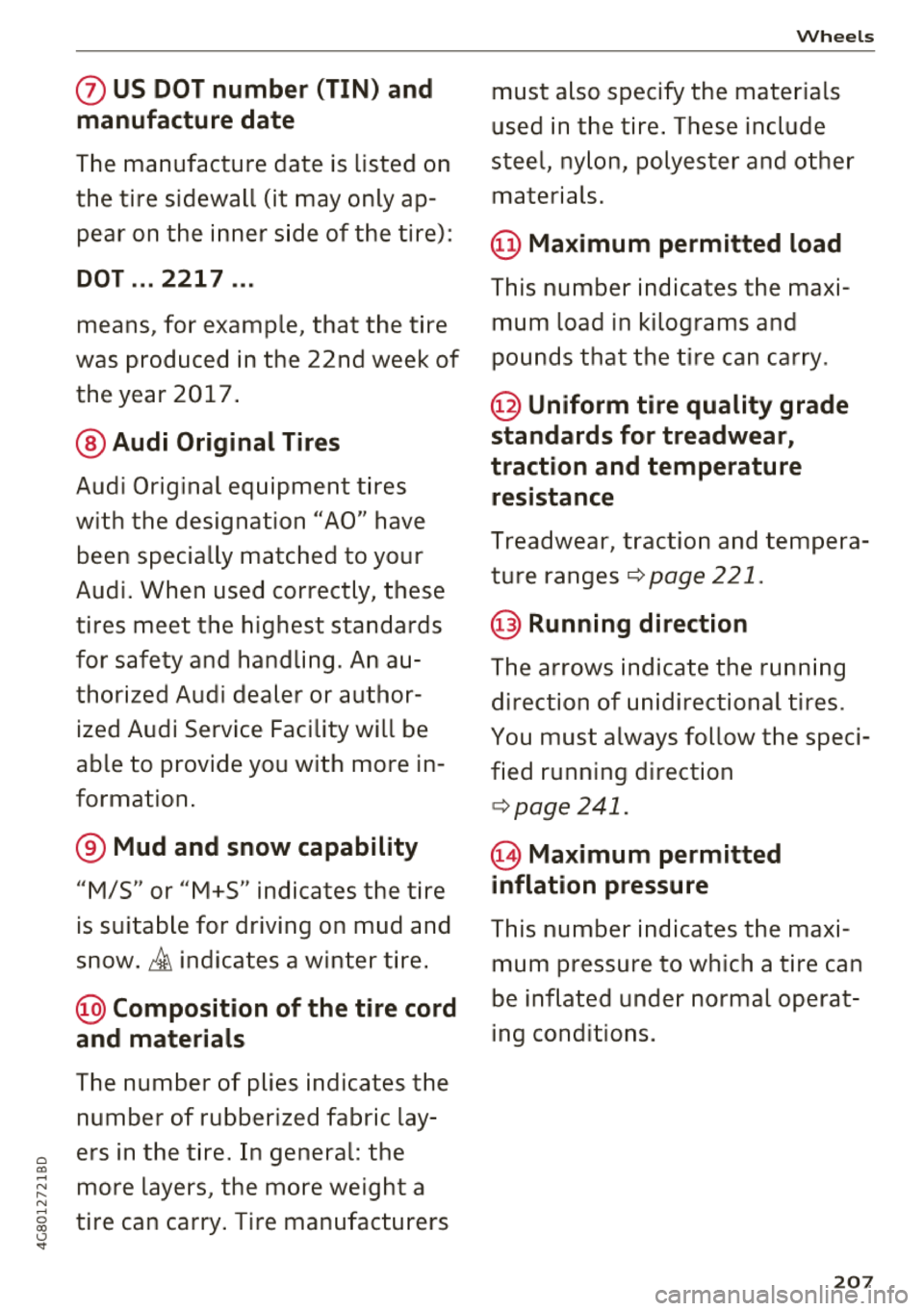
0 0)
-N ,.... N
-0 0) \.) ..
(J) US DOT number (TIN) and
manufacture date
T he manufacture date is listed on
the tire sidewall (it may only ap
pear on the inner s ide of the tire):
DOT .. . 2217 .. .
means , for example, that the tire
was produced in the 22nd week of
the year 2017 .
@ Audi Original Tires
Audi Original equipment tires
with the designation
"AO" have
been specially matched to your
Audi . When used correct ly , these
tires meet the highest standards
for safety and handling . An au
thorized Audi dealer or author
ized Audi Service Facility wi ll be
able to provide you with more in
formation .
® Mud and snow capability
"M/5 " or "M+S" indicates the tire
is suitable for driving on mud and
snow .
& indicates a winter tire .
@ Composition of the tire cord
and materials
The number of plies indicates the
number of rubberized fabric lay
ers in the tire. In general : the
more layers, the more we ight a
tire can carry . Tire manufacturers
Wh eel s
must also specify the materials
used in the tire . These include
steel, nylon, polyester and other
materials.
@ Ma ximum permitted load
This number indicates the maxi
mum load in kilograms and
pounds that the tire can carry .
@ Uniform tire qual ity grade
standards for treadwear,
traction and temperature resistance
Treadwear , tract ion and tempera
ture ranges
r=:>page221 .
@ Running direction
The arrows indicate the runn ing
direction of unidirectional tires .
You must always follow the speci
fied running direction
c> page 241.
@ Ma ximum permitted
inflation pressure
This number indicates the maxi
mum pressure to which a tire can
be inflated under normal operat
ing cond itions .
207
Page 210 of 274
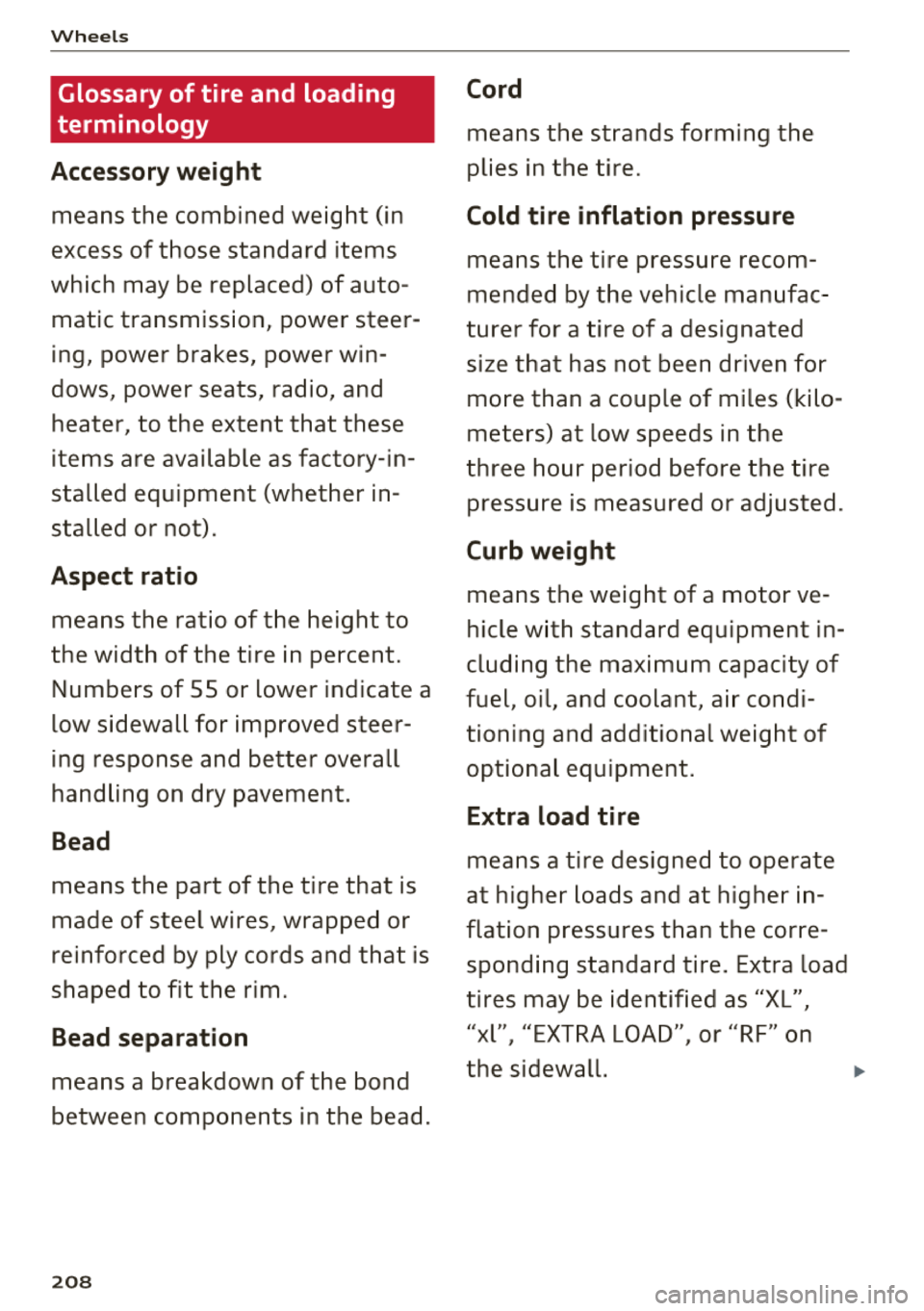
Wheel s
Glossary of tire and loading
terminology
Accessory weight
means the combined weight (in
excess of those standard items
which may be replaced) of auto matic transmission, power steer
ing , power brakes , power win
dows , power seats, radio, and
heater, to the extent that these
items are available as factory-in
stalled equipment (whether in
stalled or not).
Aspect ratio
means the ratio of the height to
the width of the tire in percent. Numbers of 55 or lower indicate a
low sidewall for improved steer
ing response and better overall
handling on dry pavement .
Bead
means the part of the tire that is
made of steel wires, wrapped or
reinforced by ply cords and that is
shaped to fit the rim.
Bead separation
means a breakdown of the bond
between components in the bead.
208
Cord
means the strands forming the
plies in the tire.
Cold tire inflation pressure
means the t ire pressure recom
mended by the vehicle manufac
turer for a tire of a designated
size that has not been driven for
more than a couple of miles (kilo
meters) at low speeds in the
three hour period before the tire pressure is measured or adjusted.
Curb weight
means the weight of a motor ve
hicle w ith standard equipment in
cluding the maximum capacity of
fuel, oil, and coolant, ai r condi
tioning and additional weight of
optional equipment.
E x tra load ti re
means a tire designed to operate
at higher loads and at higher in
flation pressures than the corre
sponding standard tire. Extra load
tires may be identified as "X L",
"
l" "EXTRA LOAD" or "RF" on X I I
the sidewall. .,.